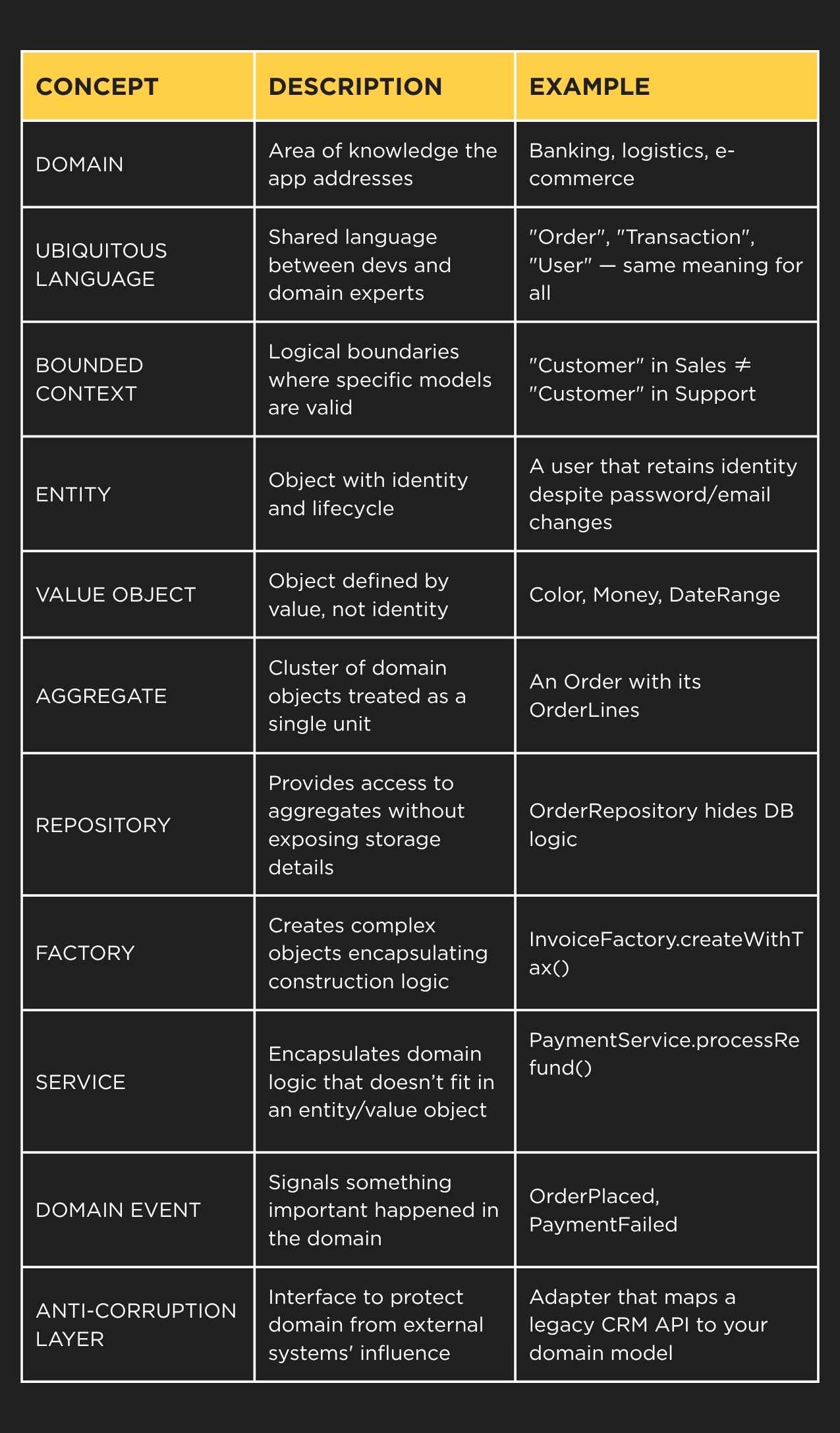What is Domain-Driven Design (DDD) and how do you use it?
In the ever-evolving landscape of software development, how do we ensure that our software not only functions seamlessly but also mirrors the intricate nuances of the business domain it serves? Enter Domain-Driven Design (DDD) – a philosophy and methodology that places the business domain at the heart of software design and development.
By emphasizing a deep understanding of the domain, fostering clear communication between technical and non-technical stakeholders, and implementing a set of best practices, DDD ensures the creation of software that's both robust and adaptable.
With this article we want to unfold the intricacies of DDD, exploring its key concepts, processes, advantages, and challenges, all elucidated with real-world examples.
What is DDD? What does the DDD stand for?
Domain-Driven Design, often abbreviated as DDD, is a methodology or approach to software design that emphasizes the importance of the domain model. The "domain" here refers to the specific problem area that the software is meant to address. DDD is primarily used in complex systems where a deep understanding of the domain is necessary to produce an effective software solution.
At its core, DDD is about bridging the gap between the technical aspects of software development and the real-world complexities of business problems.
It focuses on creating a shared language and understanding between developers and domain experts, ensuring that the software is closely aligned with the needs and nuances of its intended environment.
To put it simply, DDD is like creating a map of a business problem and then using that map to build a software solution that fits the terrain perfectly.
Key concepts of DDD
Domain-Driven Design is rich with concepts that guide developers and domain experts in the creation of effective software solutions. Here are some of the foundational ideas:
- Domain: This is the sphere of knowledge or activity around which the application is built. For a banking application, the domain might be "banking transactions," while for an e-commerce site, it might be "online shopping."
- Ubiquitous Language: A shared language established between developers and domain experts. This ensures that all stakeholders have a clear and consistent understanding, minimizing miscommunication. When someone mentions a "transaction," "product," or "user," everyone involved knows exactly what is being referred to.
- Bounded Context: This refers to the boundaries within which a particular model is defined and applicable. It ensures that terms and concepts used do not conflict with those in other contexts. For example, the concept of a "customer" in a sales system might differ from that in a support ticketing system.
- Entities: These are objects that have a distinct identity and continuity over time, even as their attributes change. An example is a "user" in a system, who retains their identity even if their email or password changes.
- Value Objects: Objects that represent descriptive aspects of the domain with no conceptual identity. For example, a "color" or "date range" might be represented as value objects.
- Aggregates: A cluster of domain objects that can be treated as a single unit. They ensure consistency and integrity within their boundaries. An example might be an "order" and its associated "order lines."
- Repositories: Mechanisms for accessing aggregates from the underlying storage system, whether that’s a database, web service, etc. They provide the illusion that objects are stored in memory.
- Factories: These are responsible for encapsulating and centralizing the complex logic required to create domain objects.
- Services: These stand apart from the natural object-oriented design concepts. When an operation doesn’t feel like it belongs to any object, it might be placed in a service.
- Domain Events: These represent something of interest that has happened in the domain. For instance, an "order placed" event might be triggered when a customer confirms a purchase.
- Anti-Corruption Layer: This is a protective barrier that translates between different systems or subsystems, ensuring that the design of one doesn't negatively impact or corrupt another.
In essence, these concepts of DDD work together to ensure that software design is a reflection of the underlying domain, promoting clarity, consistency, and business alignment.

Domain-Driven Design Process
Domain-Driven Design (DDD) offers a structured approach to building software that aligns closely with business requirements. Implementing DDD involves understanding and leveraging specific practices to ensure an effective workflow. Here’s a step-by-step guide to navigating the DDD process:
Understand the Domain
The journey into Domain-Driven Design begins with a deep dive into the problem space: the domain. To build a system that accurately represents and addresses real-world concerns, it's crucial to thoroughly understand the domain. This involves collaboration with domain experts, stakeholders, and end-users. It's about acquiring knowledge, uncovering domain concepts, and identifying the core problems that the software needs to solve.
Create an Ubiquitous Language
Once you've gained a comprehensive understanding of the domain, it's time to establish a shared vocabulary, known as the ubiquitous language. However, arriving at a shared language, even within a team of developers, can be a nuanced challenge. It's not uncommon for different individuals to use varying terms for the same concepts. Bridging this linguistic divide requires collaboration among developers, business experts, project managers, and other stakeholders. Here are steps to help achieve this shared understanding:
- Draw: One powerful way to establish a common understanding is to express your design visually, whether on a physical whiteboard or digitally.
- Create a Glossary: This glossary serves as a reference point and eliminates ambiguity in discussions. When everyone knows what each term means, miscommunications are minimized.
- Event Storming: This interactive session helps uncover hidden domain complexities, ensuring a deeper shared understanding. It's an invaluable tool for aligning the team's mental models.
- Review and Update: Regularly review it and be open to making updates when necessary. As your domain knowledge deepens and your project matures, refinements to the language will keep it accurate and relevant.
Model the Domain
With a clear understanding of the domain and a ubiquitous language in place, you can start modeling the domain. This involves creating a conceptual model that represents the key elements, behaviors, and relationships within the domain. DDD introduces powerful constructs like Aggregates, Entities, Value Objects, Repositories, Domain Services, and Application Services to help structure your domain model effectively.
Divide the Domain into Bounded Contexts
Large domains can be complex, and trying to model them as a monolithic whole can lead to confusion and inefficiency. DDD suggests dividing the domain into bounded contexts, each representing a distinct subdomain or business capability. Bounded contexts act as boundaries that encapsulate domain logic, ensuring that concepts are well-defined within their specific context and don't bleed into others.
Model the Bounded Contexts Using DDD Constructs
Once you've identified your bounded contexts, you can apply DDD constructs within each context to model the domain effectively.
- Aggregates.
- Entities.
- Value Objects.
- Repositories.
- Domain Services.
- Application Services.
Model the Architecture
As you model your bounded contexts, consider the architecture that will best support your domain model. This is where concepts like Hexagonal Architecture or Event-Driven Architecture (among others) come into play. For example, Hexagonal Architecture emphasizes the separation of concerns, making it easier to adapt and maintain the system while Event-Driven Architecture facilitates asynchronous communication, scalability, and loose coupling between components, aligning well with the principles of DDD.
The benefits of using these architectural patterns include improved modularity, testability, and scalability, as well as the ability to evolve your system more gracefully over time.
Keep Continuous Refinement as the Mindset of the Team
Domain-Driven Design is not a one-time activity but a continuous process. It's essential to embrace a mindset of continuous refinement. As the domain evolves and new insights emerge, be ready to adapt your models and architecture accordingly. Regularly engage with domain experts and stakeholders to ensure your software remains aligned with the real-world domain it represents.

How DDD complements AI System Design
As Artificial Intelligence becomes increasingly embedded in modern software products, the need for clear domain understanding is more critical than ever.
While AI brings adaptability and data-driven decision-making, it can also introduce complexity and opacity. This is where Domain-Driven Design (DDD) offers substantial value: it grounds AI systems in a well-defined, business-aligned domain model:
🔹 Improved explainability and trust: DDD promotes a shared language and transparent models, which help teams build AI systems that are easier to explain, audit, and trust, essential for compliance-heavy industries like healthcare, fintech, or legal tech.
🔹 Clear separation of concerns with bounded contexts: each machine learning model or data pipeline can exist within its own bounded context. This reduces the risk of cross-domain interference and allows teams to iterate on models independently, making AI systems more modular and scalable.
🔹 Ubiquitous language for AI collaboration: successful AI products require input from developers, data scientists, and business stakeholders. DDD’s emphasis on shared vocabulary improves collaboration, ensuring that features, datasets, and expected outcomes are clearly understood by all parties.
🔹 Event-Driven Architecture for Real-Time AI: DDD aligns well with event-driven systems, which are often required for real-time AI applications like recommendation engines or fraud detection. Domain Events help trigger ML workflows, making the system more reactive and responsive.
🔹 MLOps and Model Lifecycle Management: DDD’s clean architectural boundaries facilitate better integration with MLOps pipelines. You can isolate training, serving, and monitoring concerns while keeping the core domain logic intact, which reduces technical debt over time.
By combining DDD with AI practices, teams can deliver intelligent systems that remain grounded in real-world business logic. This blend encourages responsible innovation: smart software that behaves predictably, adapts reliably, and evolves with your product’s domain.
Pros of Domain-Driven Design Process
Domain-Driven Design (DDD) strategic and tactical approaches to software design offer various advantages, especially for complex systems. Here are some of the primary benefits of employing the DDD process:
Enhanced Communication
The ubiquitous language, a cornerstone of DDD, fosters clear and consistent communication among all stakeholders, from developers to domain experts. Everyone speaks the same language, reducing misunderstandings and promoting collaborative problem solving.
Strategic Alignment with Business:
By focusing on the core domain and its intricacies, DDD ensures that the software aligns closely with business goals and priorities. This results in software that effectively meets the needs and challenges of the business.
Improved Software Flexibility:
DDD's focus on bounded contexts allows different parts of a system to evolve independently. This modular approach ensures that changes in one area don’t unnecessarily disrupt another, making the software more adaptable to evolving requirements.
Consistency and Integrity:
By using aggregates, DDD ensures that data changes are consistent and maintain the integrity of the domain. This reduces the chances of data corruption and inconsistencies.
Clearer Software Architecture:
It's important to clarify that DDD is not a specific architectural model itself, but rather an approach or methodology that encourages the emergence of cleaner architectures. We can mention Hexagonal, CQRS (Command Query Responsibility Segregation), and Event Sourcing as the most prevalent architectural choices that are frequently employed to implement DDD principles effectively. These architectural patterns contribute to the clear separation of concerns, enhancing the maintainability and comprehensibility of the software system, which is one of the key benefits of applying DDD principles.
Scalability and Performance:
By adopting practices like flat aggregate roots and employing read models for complex systems, DDD facilitates improved performance and scalability of applications.
Reactive System Development:
With its emphasis on domain events, DDD paves the way for building reactive systems that respond to changes and events in the domain, making the system more responsive and user-friendly.
Reduced Software Entropy:
By providing clear guidelines and best practices, DDD helps in keeping the software design clean, which in turn reduces the entropy or gradual decline in software quality over time.
Encourages Continuous Collaboration:
DDD isn't just a set of practices; it's a mindset. It promotes continuous collaboration between developers and domain experts, ensuring that the software remains relevant and effective as the domain evolves.
Cost Efficiency in the Long Run:
While DDD might require an initial investment in terms of time and effort to understand the domain, the long-term benefits of fewer errors, reduced rework, and easier feature additions can lead to overall cost savings.
Cons of Domain-Driven Design Process
While the Domain-Driven Design process offers a myriad of benefits, particularly for complex systems, it's not without its challenges. For starters, DDD requires a significant upfront investment in time and effort to thoroughly understand the domain. This can be daunting and may not always be practical for projects with tight deadlines or limited resources.
Furthermore, DDD's emphasis on collaboration between developers and domain experts necessitates continuous communication, which, while advantageous, can be resource-intensive and may lead to decision paralysis if not managed properly. The granularity of the design, with its myriad entities, value objects, and aggregates, can sometimes lead to over-engineering, adding unnecessary complexity to the software.
This complexity, in turn, can result in a steeper learning curve for new team members or those unfamiliar with DDD principles. Moreover, for projects that are more straightforward or don't anticipate significant domain complexities, the rigor and depth of DDD might be overkill, making simpler design approaches more appropriate.
In essence, while DDD is a powerful tool in the software designer's arsenal, it's essential to assess whether its depth and complexity align with the project's needs and constraints.
What do you think? Did you know all these details of DDD?
If you want to stay up to date, follow the Acid Tango blog and leave a comment if you have any doubts.
Questions that often come up about DDD
What is Domain-Driven Design (DDD) in simple terms?
Domain-Driven Design is a software development approach that centers the design process around the business domain. It helps teams accurately model real-world problems using a shared language, well-defined boundaries, and concepts like entities, value objects, and domain services.
Why is DDD useful for complex software systems?
In complex systems, ambiguity kills velocity. DDD reduces that ambiguity by encouraging deep collaboration between technical and business stakeholders, resulting in software that's aligned with real needs and easier to evolve over time.
How does Domain-Driven Design relate to Artificial Intelligence?
DDD helps structure AI-powered systems by grounding them in a clearly defined domain model. This makes machine learning components easier to reason about, monitor, and align with business objectives — especially when multiple teams are involved.
Can DDD be applied to machine learning projects?
Absolutely. While DDD wasn’t originally created with ML in mind, its principles fit naturally with modern machine learning operations (MLOps). Each model or pipeline can be isolated within its own bounded context, reducing dependencies and making the system more maintainable.
What is a bounded context and why does it matter?
A bounded context defines the limits of a domain model — where its definitions and rules apply. This prevents concept drift across large systems and helps different teams work independently without breaking each other's logic. It’s especially valuable in AI systems with distinct models or datasets.
When is DDD not a good idea?
DDD adds overhead, so it's not ideal for simple applications, short-lived prototypes, or teams without access to domain experts. If your problem space is well-understood and unlikely to change, simpler design approaches may be more practical.
What industries or products benefit most from DDD?
Industries like finance, healthcare, logistics, insurance, and e-commerce — all benefit from DDD due to the complexity and evolution of their business rules. The same goes for AI-driven products that require long-term scalability and interpretability.
What architectures support DDD best?
While DDD is methodology-based and not tied to a specific architecture, it's often implemented with Hexagonal Architecture (Ports and Adapters), CQRS, and Event Sourcing. These patterns support separation of concerns and allow systems to grow without becoming fragile.
Do I need a specific language or framework to use DDD?
No. DDD can be applied in any language or tech stack. What matters most is how you model your domain and organize your codebase around it — not the tools you use to implement it.
